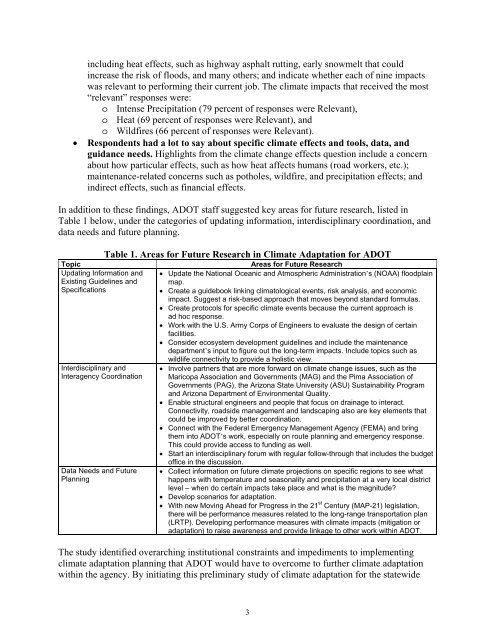SPR-696: Preliminary Study of Climate Adaptation for the Statewide ...
SPR-696: Preliminary Study of Climate Adaptation for the Statewide ...
SPR-696: Preliminary Study of Climate Adaptation for the Statewide ...
You also want an ePaper? Increase the reach of your titles
YUMPU automatically turns print PDFs into web optimized ePapers that Google loves.
including heat effects, such as highway asphalt rutting, early snowmelt that couldincrease <strong>the</strong> risk <strong>of</strong> floods, and many o<strong>the</strong>rs; and indicate whe<strong>the</strong>r each <strong>of</strong> nine impactswas relevant to per<strong>for</strong>ming <strong>the</strong>ir current job. The climate impacts that received <strong>the</strong> most“relevant” responses were:o Intense Precipitation (79 percent <strong>of</strong> responses were Relevant),o Heat (69 percent <strong>of</strong> responses were Relevant), ando Wildfires (66 percent <strong>of</strong> responses were Relevant).Respondents had a lot to say about specific climate effects and tools, data, andguidance needs. Highlights from <strong>the</strong> climate change effects question include a concernabout how particular effects, such as how heat affects humans (road workers, etc.);maintenance-related concerns such as potholes, wildfire, and precipitation effects; andindirect effects, such as financial effects.In addition to <strong>the</strong>se findings, ADOT staff suggested key areas <strong>for</strong> future research, listed inTable 1 below, under <strong>the</strong> categories <strong>of</strong> updating in<strong>for</strong>mation, interdisciplinary coordination, anddata needs and future planning.TopicUpdating In<strong>for</strong>mation andExisting Guidelines andSpecificationsInterdisciplinary andInteragency CoordinationData Needs and FuturePlanningTable 1. Areas <strong>for</strong> Future Research in <strong>Climate</strong> <strong>Adaptation</strong> <strong>for</strong> ADOTAreas <strong>for</strong> Future Research Update <strong>the</strong> National Oceanic and Atmospheric Administration’s (NOAA) floodplainmap. Create a guidebook linking climatological events, risk analysis, and economicimpact. Suggest a risk-based approach that moves beyond standard <strong>for</strong>mulas. Create protocols <strong>for</strong> specific climate events because <strong>the</strong> current approach isad hoc response. Work with <strong>the</strong> U.S. Army Corps <strong>of</strong> Engineers to evaluate <strong>the</strong> design <strong>of</strong> certainfacilities. Consider ecosystem development guidelines and include <strong>the</strong> maintenancedepartment’s input to figure out <strong>the</strong> long-term impacts. Include topics such aswildlife connectivity to provide a holistic view. Involve partners that are more <strong>for</strong>ward on climate change issues, such as <strong>the</strong>Maricopa Association and Governments (MAG) and <strong>the</strong> Pima Association <strong>of</strong>Governments (PAG), <strong>the</strong> Arizona State University (ASU) Sustainability Programand Arizona Department <strong>of</strong> Environmental Quality. Enable structural engineers and people that focus on drainage to interact.Connectivity, roadside management and landscaping also are key elements thatcould be improved by better coordination. Connect with <strong>the</strong> Federal Emergency Management Agency (FEMA) and bring<strong>the</strong>m into ADOT’s work, especially on route planning and emergency response.This could provide access to funding as well. Start an interdisciplinary <strong>for</strong>um with regular follow-through that includes <strong>the</strong> budget<strong>of</strong>fice in <strong>the</strong> discussion. Collect in<strong>for</strong>mation on future climate projections on specific regions to see whathappens with temperature and seasonality and precipitation at a very local districtlevel – when do certain impacts take place and what is <strong>the</strong> magnitude? Develop scenarios <strong>for</strong> adaptation. With new Moving Ahead <strong>for</strong> Progress in <strong>the</strong> 21 st Century (MAP-21) legislation,<strong>the</strong>re will be per<strong>for</strong>mance measures related to <strong>the</strong> long-range transportation plan(LRTP). Developing per<strong>for</strong>mance measures with climate impacts (mitigation oradaptation) to raise awareness and provide linkage to o<strong>the</strong>r work within ADOT.The study identified overarching institutional constraints and impediments to implementingclimate adaptation planning that ADOT would have to overcome to fur<strong>the</strong>r climate adaptationwithin <strong>the</strong> agency. By initiating this preliminary study <strong>of</strong> climate adaptation <strong>for</strong> <strong>the</strong> statewide3
















